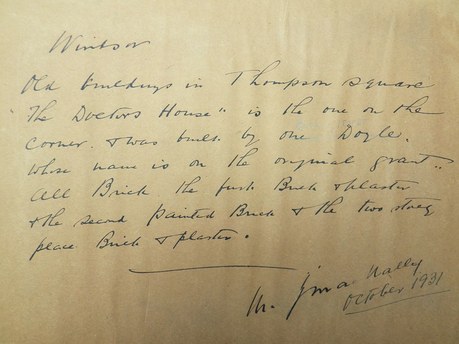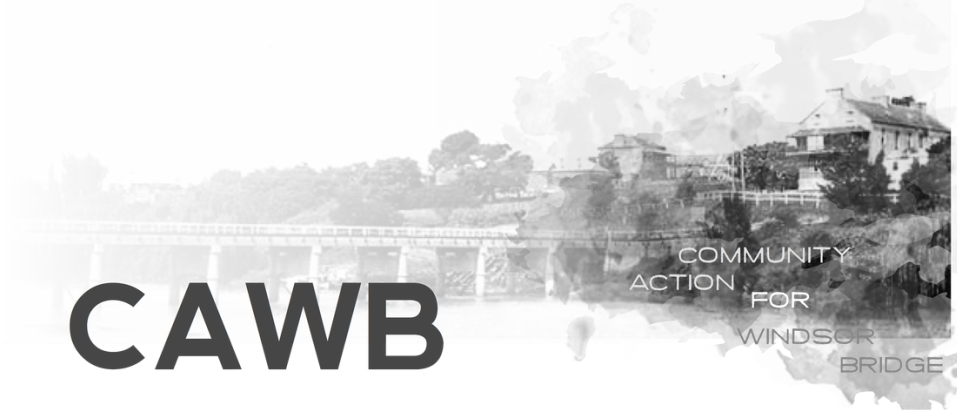
In 1931, two Windsor residents decided to work on a manuscript to describe some of the old buildings of Windsor and surrounding districts. Historian, George Reeve did most of the written research. He had spent the best part of 10 years interviewing and discussing with older residents their recollections of Windsor, its people and its buildings. He also uses references from the relevant books of the day such as “The Early Days of Windsor” by Jas Steele. From this he produced an illustrated record in 14 watercolours and hand written script – this is held by the Mitchell Library, Sydney.
It can be seen from the text of the manuscript that historians at that time had limited resources and relied for much of their information on the recollections of older folk in the community and on access to newspapers and recently published histories. So it may be that there are some inaccuracies in what they have recorded but they also provide an on the ground insight into what it was like in Windsor in the 1920’s and 1930’s. Now we have powerful search aids like the internet which enables us to whizz through piles of indexed information held all over the world without leaving our houses.
The first article we will be privileged to view is one set in Thompson Square.
It deals with the Doctor’s House and to some extent with the adjacent cottage and Howe House. It does pose some questions which may be able to be sorted with a little research. Read Mr Reeve’s first article, meet Mrs Emma “Granny” Butler, find out about Mr James Doyle of Thompson Square and enjoy the lovely watercolour by MacNally, who also wrote some interesting details on the reverse of the image.
DOYLE HOUSE, Facing THOMPSON SQUARE, WINDSOR.
During the course of some 10 years (1915 – 1925) making enquiries, searches and investigations of the old buildings of Windsor, acquiring first hand knowledge by personal walks around the streets of Windsor with many individual natives of the old town, amongst whom was a splendid and intelligent old lady who was born, so she informed me, at her father’s hotel , Joseph Delaundre’s named the “Sign of St Patrick Inn”, George Street, Windsor(1835) – the year of its opening. This lady – Emma M. Butler (“Granny” Butler) I particularly asked her about the buildings facing Thompson Square. That was some time during the 1920’s. She told me that as a girl, she knew the history of all the buildings from her Grandmother, Mrs Izzard, wife of the man who looked after the running of the Punt or Ferry which ran to and fro from the Wilberforce, Freeman’s Reach side. Mrs Butler’s grandmother living in a cottage in Baker St at the back of what is known as Burke’s buildings, the large block of buildings known also as “Doctor’s Row.”
“Burke’s buildings date from 1845. Mrs Butler stated that she knew the vicinity very well as she was often, as a girl, at Mrs Izzard’s. The cottage in Thompson Square was known as Doyle’s Cottage or House and she said it was built in 1827 as a residence for Mr James Doyle ( whose history previous to his arrival at Windsor does not appear to be known) but while Mr Doyle was a citizen of the old town, he was possessed of much wealth and means, as will be seen from the extracts quoted. It was at Doyle Cottage that James Doyle died as can be seen from a record in the Sydney Herald April 4 1936 -
DEATH ( Doyle)
“On the second instant at his residence, Thompson Square, Windsor, Mr James Doyle, after a severe and lingering illness.”
The Sydney Herald has the following paragraph about Mr Doyle – “ We understand that Mr James Doyle of Windsor has bequeathed the sum of 200 Pound to the Benevolent Society and 100 Pound in aid of the funds for the Sydney Dispensary.”
The Sydney Gazette contains the following paragraph – Mr Doyle, late of Windsor, deceased, who has thought to have died possessed of considerable wealth has left some few charitable donations it is said, he bequeathed 500 Pound towards the completion of the handsome structure the R.C. Chapel, Hyde Park, Sydney and 100 Pound towards the dedication of a Chapel at Windsor.”
At the Catholic Burial ground of St Matthew’s Windsor, a large vault tomb bears on its top the following inscription :-
“ Here Lieth in the Hope of a Glorious Resurrection the Body of James Doyle Who Departed This Life April 2nd Aged 73 Years.”
The following verse also appears thereon, the exact rendition here within may or may not be accurate as the words are in some instances indecipherable -
“ Thou loveth the beloved ones abpot thee, not To whom related or to whom begat – A heap of clay is all that remains of thee, Its all those around, all the proud shall be.”
From an earlier announcement of a marriage which appears in the Sydney Gazette Oct. 25th 1822, it would seem that Mr James Doyle was a wealthy man – MARRIED (Browne – Doyle) “ By special license by the Rev. Mr Cross at Windsor Church on Saturday Oct 13 1822, John Browne, son of William Browne, one of the Magistrates of the Teritory to Miss Mary Bertha Berthina Bridget Doyle only child and heiress of Mr James Doyle of Windsor.”
It should be stated that the pioneers Andrew and Isabella Doyle who settled in the Hawkesbury shortly after their arrival with their family by the “Fulla” 1803 were not related in any way to Mr James Doyle who built the residence in Thompson Square.
Mrs Emma Butler who told me of “Doyle Cottage” Windsor, died at the Windsor Hospital on July 30 1926 aged 91 years.
George G. Reeve 1931
So, Mr James Doyle was a prominent Square Man! Never fear – your CAWB historians have been hard at work delving through the internet and have uncovered Mr James Doyle’s hidden past. Stay tuned for further updates. There's another good story from our Thompson Square past waiting to be told!
It can be seen from the text of the manuscript that historians at that time had limited resources and relied for much of their information on the recollections of older folk in the community and on access to newspapers and recently published histories. So it may be that there are some inaccuracies in what they have recorded but they also provide an on the ground insight into what it was like in Windsor in the 1920’s and 1930’s. Now we have powerful search aids like the internet which enables us to whizz through piles of indexed information held all over the world without leaving our houses.
The first article we will be privileged to view is one set in Thompson Square.
It deals with the Doctor’s House and to some extent with the adjacent cottage and Howe House. It does pose some questions which may be able to be sorted with a little research. Read Mr Reeve’s first article, meet Mrs Emma “Granny” Butler, find out about Mr James Doyle of Thompson Square and enjoy the lovely watercolour by MacNally, who also wrote some interesting details on the reverse of the image.
DOYLE HOUSE, Facing THOMPSON SQUARE, WINDSOR.
During the course of some 10 years (1915 – 1925) making enquiries, searches and investigations of the old buildings of Windsor, acquiring first hand knowledge by personal walks around the streets of Windsor with many individual natives of the old town, amongst whom was a splendid and intelligent old lady who was born, so she informed me, at her father’s hotel , Joseph Delaundre’s named the “Sign of St Patrick Inn”, George Street, Windsor(1835) – the year of its opening. This lady – Emma M. Butler (“Granny” Butler) I particularly asked her about the buildings facing Thompson Square. That was some time during the 1920’s. She told me that as a girl, she knew the history of all the buildings from her Grandmother, Mrs Izzard, wife of the man who looked after the running of the Punt or Ferry which ran to and fro from the Wilberforce, Freeman’s Reach side. Mrs Butler’s grandmother living in a cottage in Baker St at the back of what is known as Burke’s buildings, the large block of buildings known also as “Doctor’s Row.”
“Burke’s buildings date from 1845. Mrs Butler stated that she knew the vicinity very well as she was often, as a girl, at Mrs Izzard’s. The cottage in Thompson Square was known as Doyle’s Cottage or House and she said it was built in 1827 as a residence for Mr James Doyle ( whose history previous to his arrival at Windsor does not appear to be known) but while Mr Doyle was a citizen of the old town, he was possessed of much wealth and means, as will be seen from the extracts quoted. It was at Doyle Cottage that James Doyle died as can be seen from a record in the Sydney Herald April 4 1936 -
DEATH ( Doyle)
“On the second instant at his residence, Thompson Square, Windsor, Mr James Doyle, after a severe and lingering illness.”
The Sydney Herald has the following paragraph about Mr Doyle – “ We understand that Mr James Doyle of Windsor has bequeathed the sum of 200 Pound to the Benevolent Society and 100 Pound in aid of the funds for the Sydney Dispensary.”
The Sydney Gazette contains the following paragraph – Mr Doyle, late of Windsor, deceased, who has thought to have died possessed of considerable wealth has left some few charitable donations it is said, he bequeathed 500 Pound towards the completion of the handsome structure the R.C. Chapel, Hyde Park, Sydney and 100 Pound towards the dedication of a Chapel at Windsor.”
At the Catholic Burial ground of St Matthew’s Windsor, a large vault tomb bears on its top the following inscription :-
“ Here Lieth in the Hope of a Glorious Resurrection the Body of James Doyle Who Departed This Life April 2nd Aged 73 Years.”
The following verse also appears thereon, the exact rendition here within may or may not be accurate as the words are in some instances indecipherable -
“ Thou loveth the beloved ones abpot thee, not To whom related or to whom begat – A heap of clay is all that remains of thee, Its all those around, all the proud shall be.”
From an earlier announcement of a marriage which appears in the Sydney Gazette Oct. 25th 1822, it would seem that Mr James Doyle was a wealthy man – MARRIED (Browne – Doyle) “ By special license by the Rev. Mr Cross at Windsor Church on Saturday Oct 13 1822, John Browne, son of William Browne, one of the Magistrates of the Teritory to Miss Mary Bertha Berthina Bridget Doyle only child and heiress of Mr James Doyle of Windsor.”
It should be stated that the pioneers Andrew and Isabella Doyle who settled in the Hawkesbury shortly after their arrival with their family by the “Fulla” 1803 were not related in any way to Mr James Doyle who built the residence in Thompson Square.
Mrs Emma Butler who told me of “Doyle Cottage” Windsor, died at the Windsor Hospital on July 30 1926 aged 91 years.
George G. Reeve 1931
So, Mr James Doyle was a prominent Square Man! Never fear – your CAWB historians have been hard at work delving through the internet and have uncovered Mr James Doyle’s hidden past. Stay tuned for further updates. There's another good story from our Thompson Square past waiting to be told!


